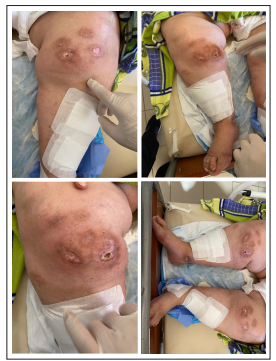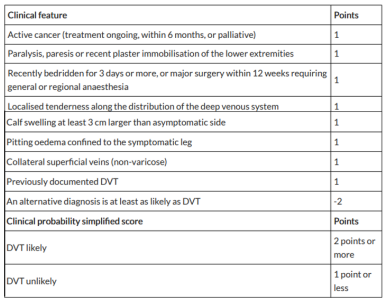Author(s): Mohammad Abu-Jeyyab*, Omar Yousef, Mohammad Al-Jafari, Mutayam Abu-Qudairi, Ammar Al-Titi, Mohammad Al-share and Mohammad Almusedien
The lower extremity Deep vein thrombosis is a disorder caused by blood stasis in the veins of the lower limbs. It is a prevalent ailment in middle-aged
and elderly people. It is more prevalent in males, as previously said, although it is still common in girls. Furthermore, it is often linked to immobility and
cardiac illnesses such as heart failure and atrial fibrillation.
Thrombosis is described as the forming of a blood clot in a blood artery, which obstructs the flow of blood toward peripheral tissues and causes blood to flow too sluggish through veins. Bilateral deep venous thrombosis (DVT) is a disorder in which a blood clot develops in both legs’ deep veins. This causes leg discomfort, swelling, and redness, as well as edema, the most particular sign of DVT [1].
DVT is the third most cause of mortality in the world, and it can cause catastrophic consequences such as pulmonary embolism, which occurs when the clot detaches and goes to the lungs, obstructing one of the pulmonary arteries. The femoral and iliac veins are the most commonly implicated veins by DVT; however, arm veins, mesenteric veins, and cerebral veins can also be involved [2,3].
We present a case of a 78-year-old female patient with chronic kidney disease which was superimposed by an acute kidney injury and was admitted for the bilateral deep vein thrombosis.
A 79 years old female patient, who is a known case of hypertension, heart failure, ischemic heart disease, atrial fibrillation, dyslipidemia, and chronic kidney disease which may be complicated by acute kidney injury suggested by patient symptoms, presented to the emergency department complaining of exacerbating bilateral lower limb edema which complicated by multiple ulcers for more than eight-month. The patient is also anuric. The patient is smoking-free and is on furosemide 40mg, Bisoprolol 5mg, and Valsartan 80mg. The patient is on Digoxin for heart failure and atorvastatin for dyslipidemia. By clinical examination, the patient looks well, conscious, oriented, Alert, and bedridden. Vital signs are normal. By inspection, there is symmetrical leg swelling, erythema, and multiple ulcers. On palpation, the edema is pitting, and tenderness occurred by touching the swollen legs.

In this study, we have a case of 78 years old female patient with CKD superimposed by AKI who is diagnosed with bilateral deep vein thrombosis Bilateral lower limb venous duplex showed both common femoral veins and popliteal appear noncompressible with echogenic content. D dimer is elevated.
ECG showed broad monophasic R wave in lateral leads (I, aVL, V5-6) which indicates LBBB and irregularly irregular rhythm which confirms atrial fibrillation. Also leads I and AVL are (+) and leads II and AVF (-) shows LAD.
Blood tests including CBC, LFT and urinalysis were performed and were normal. However, kidney function test when performed revealed elevated Cr levels 264 umol/L (ref 53-97 umol/L), elevated urea 33.1 mmol/L (2.1-8.5 mmol/L) and low calcium level 1.71 mmol/L (2.2 - 2.7 mmol/L) Coagulation profile as follow: PT 18.2 s (ref 11-12.5s), PTT 47.2 s (ref 25-35s), and INR 1.37 (1.1 or below).
Venous thrombosis considered as a disease of aging, with a low rate of about 1 per 10,000 annually before the fourth decade of life, rising rapidly after age 45 years, and approaching 5-6 per 1000 annually by age 80 [4]. Deep vein thrombosis (DVT) refers to the formation of one or more blood clots in one of the body’s large veins, most commonly in the lower limbs (e.g., lower leg or calf) [5]. This can cause partial or complete blocking of circulation in the vein, which in some patients leads to pain, swelling, tenderness, discoloration or redness of the affected area, and skin that is warm to the touch. However, approximately half of all DVT episodes produce few, if any, symptoms [6]. For some patients, DVT is an acute episode, but roughly 30 percent of patients suffer additional symptoms, including leg pain and swelling, recurrent skin breakdown, and painful ulcers [7]. In addition, individuals experiencing their first DVT remain at increased risk of later episodes throughout the rest of their lives [8,9]. In a study done by Albert W Tsai, it was found the 8-year rate among those 85 and older at baseline was 13-fold greater than in those aged 45-55, with an absolute rate of 7 per 1000 annually Rates increase sharply after around age 45 years and are slightly higher in men than women in older age [10,11].
While deep vein thrombosis is a common disease, bilateral deep vein thrombosis considered a rare entity. In a prospective study, 157 inpatients with clinical suspicion of deep venous thrombosis underwent duplex scan evaluation of the lower extremities. Demographic characteristics, physical examination data, and risk factor information were collected. In all, 57 (36.3%) patients evaluated presented echo graphic evidence of acute deep venous thrombosis. Forty-six individuals presented unilateral thrombosis, and 11 patients presented bilateral disease (19.3% of all thrombosis, 7.0% of all patients). Sensitivity and specificity of clinical examination in finding bilateral thrombosis was 27.2% and 93.3%, respectively. For the risk factors evaluated, active human immunodeficiency virus disease and iliofemoral thrombosis presented an increased risk for bilateral thrombosis (P = .045 and P = .049, respectively) [12]. Here in our case, the patient had other risk factors like immobility, heart failure and atrial fibrillation, which are considered a reliable risk factor in deep vein thrombosis in general.
Another disease that can cause deep vein thrombosis in young age adults is May-Thurner syndrome. Which was described by May and Thurner in 1957 [13]. The condition typically affects young-aged to middle-aged women, particularly those in the peripartum period, or on oral contraceptives [14]. This syndrome is characterized by abnormal positioning of the right common iliac artery which results in compression on the left common iliac vein, resulting in impeded venous return and a propensity for DVT. The incidence is about 20% though this is likely an underestimation as patients is often initially asymptomatic. In addition, bilateral deep vein thrombosis is considered as one of manifestations of KILT syndrome which is a very rare condition that associates inferior vena cava abnormalities, renal defects and venous thrombosis. These vascular disorders appear in 0.6-2% of patients with cardiovascular events and condition a venous stasis that contributes to the formation of thrombus in the lower limbs [15].
The diagnosis of DVT of the leg can be difficult with clinical findings and history being unreliable. The National Institute of Health and Care Excellence (NICE) had published guidance on the detection and subsequent management of DVT and suggests the incorporation of a clinical prediction score (Wells score), d-dimer test, and venous duplex ultrasound. The use of the two-level DVT Wells score is recommended to estimate the probability of DVT, Patients with a score of 2 points or more should be offered a venous duplex ultrasound scan carried out within 4 hours of being requested. If a venous duplex ultrasound scan is not available within 4 h of being requested, a D-dimer test and temporary 24 h dose of parental anticoagulation is suggested. In the case of a low Wells score, a D-dimer test is suggested. D-dimer test is used to rule out DVT and remove the need for more expensive testing [16].
Table 1: Two-level DVT Wells score

Anticoagulation therapy is the basis of treatment. Most DVT patients may be managed out patiently with low-molecularweight heparin or Penta saccharide (fondaparinux). The period of anticoagulation is determined by whether the original incident was idiopathic or caused by a transitory risk factor. Interventions like thrombolysis and the insertion of an inferior vena cava filter are reserved for extreme cases [17,18].
Bilateral DVT in such a patient- with a previse history of many comorbidities and was newly presented with an acute kidney injuryis a difficult in diagnosis and treatment plan implementation. This article should be a nucleus for much future research in this topic.
As per university standard guideline, an Arabic consent and ethical approval form have been collected and preserved by the author.
The authors have declared that no competing interests exist.
This research did not receive any specific grant from funding agencies in the public, commercial, or not-for-profit sectors.
The authors wish like to thank The Mutah Research and Audit society (MRAS) for their supervision and mentoring the article.
